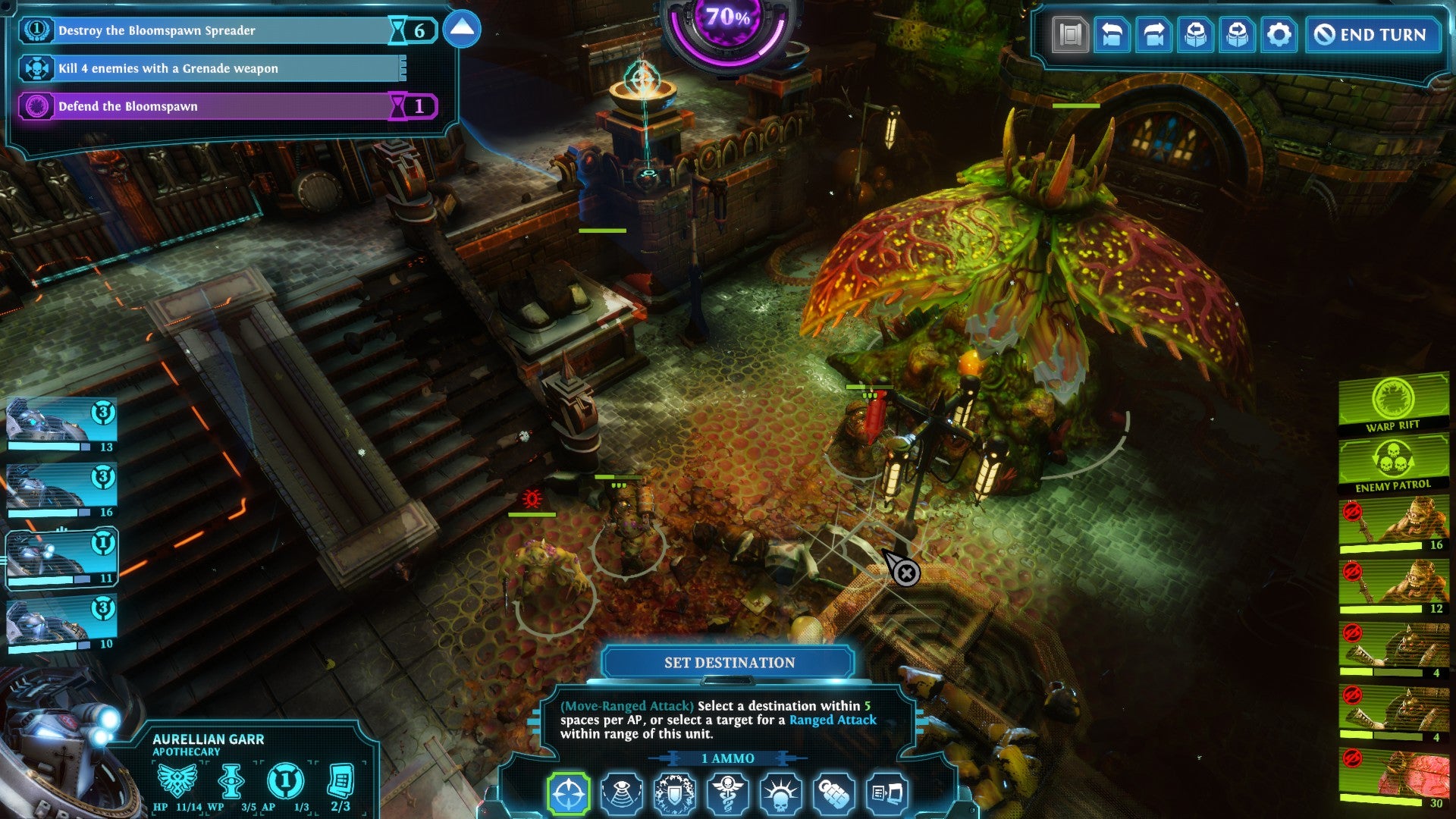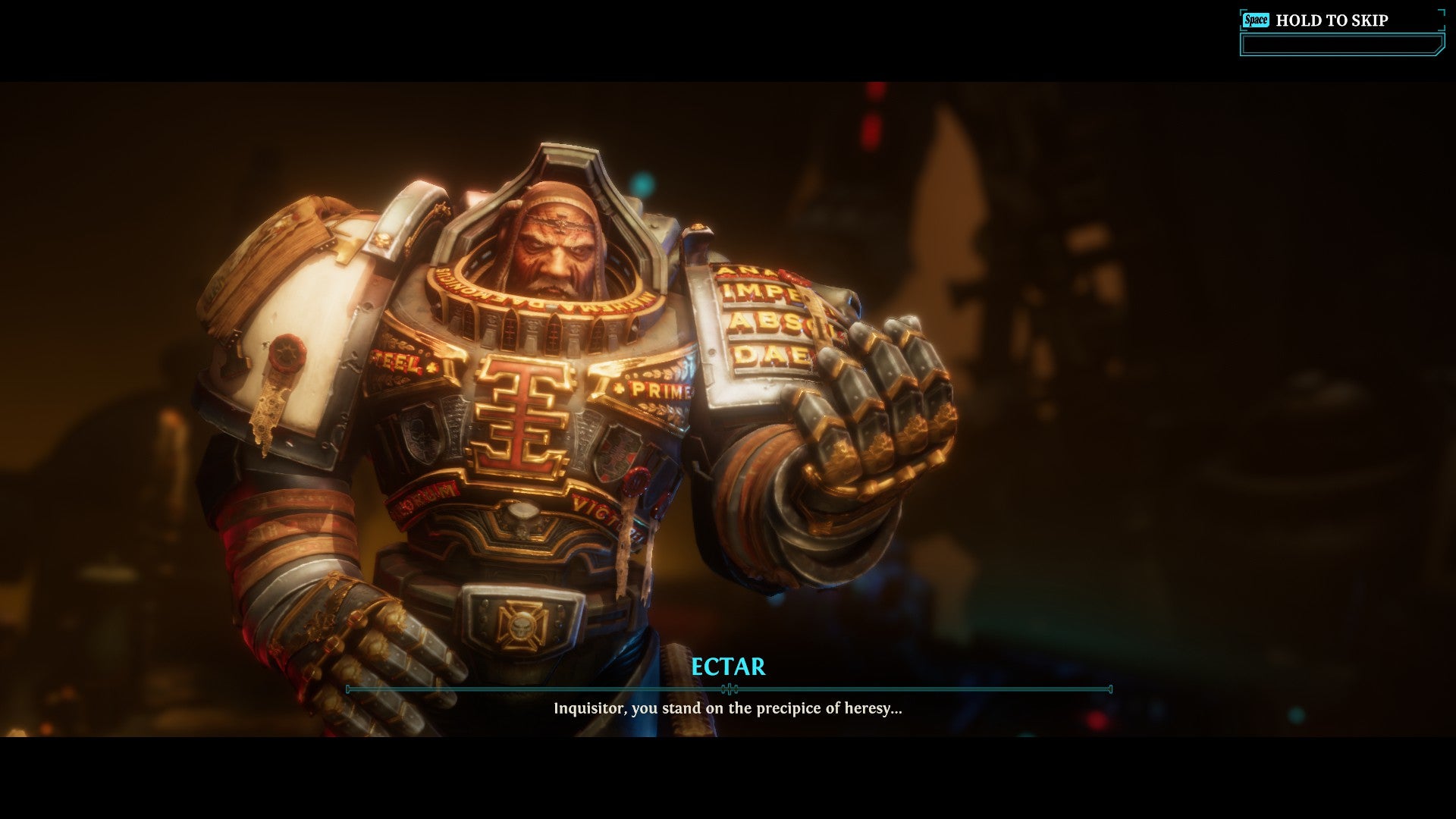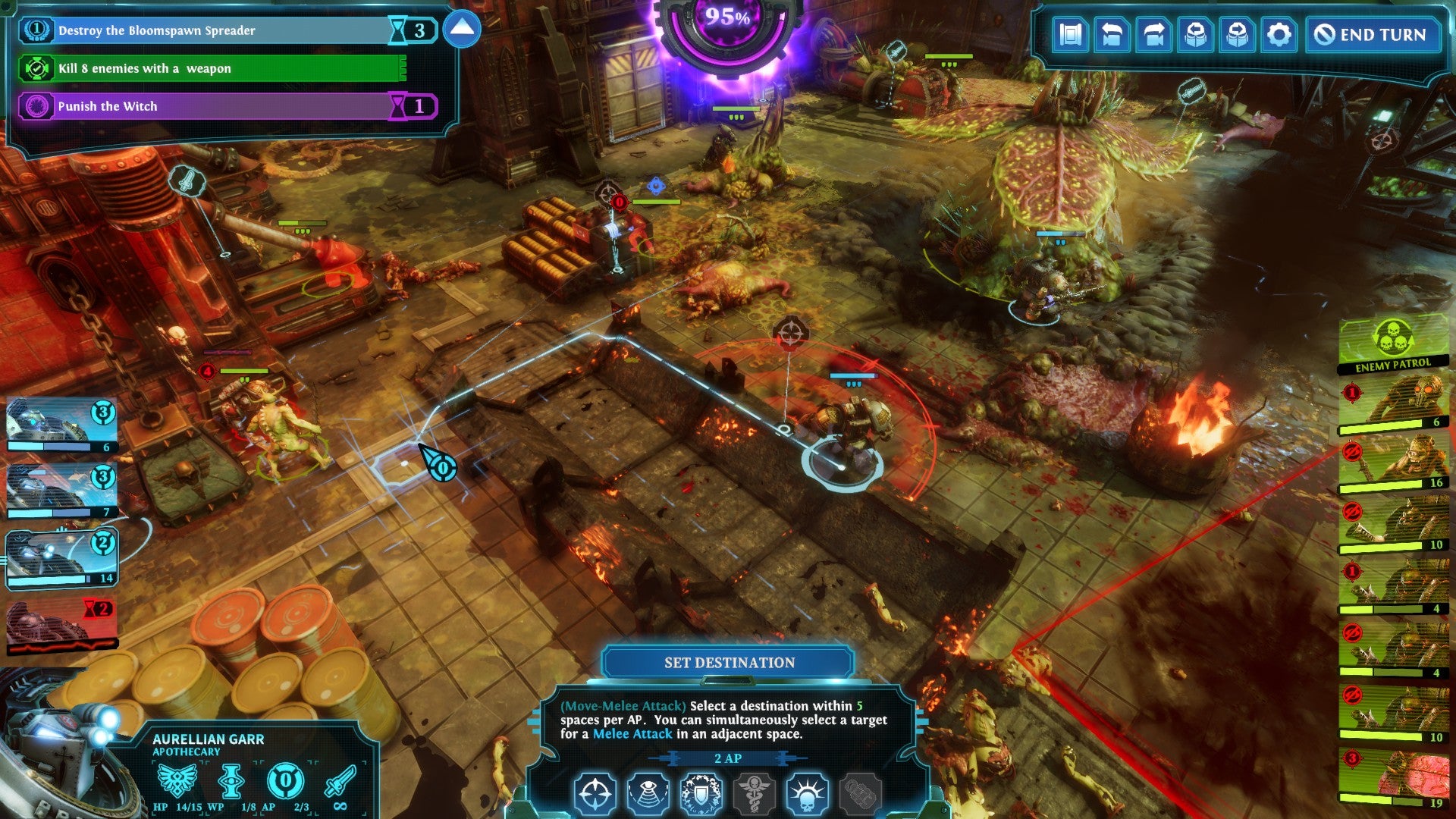You don’t expect a delicate handling of inspirations or considerate presentation from such a setting: you expect clashing cogs and excessive crenelations and hint windows that read like catechisms. You expect things to wallow like a Dreadnought knee-deep in Plaguebearer offal. But save for that slight (and to be fair, genre-typical) over-reliance on grinding to help the plot over the next hilltop, Daemonhunters positively glides. At a glance the interface looks like a Borg sneezed all over a cathedral, but in practice this is both a fine balance of ideas from XCOM and Gears Tactics, and a crisp boiling-down of a gargantuan fiction that somehow renders everything digestible, even snappy, without sacrificing the source material’s morbid intricacy. It helps that the specific Warhammer 40k Space Marine chapter you control in Daemonhunters might have been custom-designed for an XCOM-style game - the Grey Knights, a secretive order who fight in small groups against overwhelming numbers, surgically uprooting Chaos infestations as an extension of the Imperial Inquisition. As the story begins, the good ship Baleful Edict is on its way home to Titan after an especially bloody campaign, having lost its previous Commander during the final (tutorial) battle. As his disembodied mute replacement, you have only moments to get to know your lieutenant Ectar and Tech Priest (or chief engineer) Lunete before the Edict is commandeered by the inquisitor Vakir, who has detected a mysterious Nurgle “Bloom” on nearby planets. Nurgle is the Chaos god of disease, decay and rebirth, and something of a New Weird folk hero in these posthuman, chthulucentric times, but Space Marines have no patience for hippy environmentalist sci-fi, so off you go to stomp all over the Fly Lord’s glorious mouldy designs. Infected planets work like cities in XCOM: outbreaks pop up in threes on your holographic star map, and you usually only have the time to reach one before the infection levels up, which makes subsequent battles on that planet more dangerous, with additional, tougher species of Chaos demon and more frequent “Warp Surges” debuffing your Marines while empowering their foes. When not purging planets, slowly improving the Edict’s research and construction facilities - a small but gorgeous selection of menu tabs with individual theme tunes - and tending to your squads of bellowing robo-exterminators, you’ll be playing office diplomat. Daemonhunters is broadly a cosmic witchhunt, but it functions more often like a theocratic workplace comedy. All your colleagues have it in for the others. Vakir is a snotty outside consultant who treats the whole thing like her personal science project, always insisting that you dig deeper into the Bloom’s origins than seems devout, or safe. Ectar is pleasant enough when you chat alone, but he’s also a grizzly curmudgeon who likes to do things by a very short book titled “kill on sight”. Lunete is C3PO after a thousand years working for Jabba the Hutt’s IT department; she regards the others as misbehaving ship systems with obsolete fleshy bits, and isn’t shy about telling you this. Squabbles are routine, whether in the shape of major plot developments or pop-up story events that ask you to pick a side. Problematically, your underlings are also avatars for Daemonhunters’ upgrade, research and base construction elements - tell Ectar off for “tidying up” Vakir’s reports and he’ll sulk for 30 days, setting back your mission XP earnings by 50%. You’re also periodically interrupted by messages from Grey Knight grandmaster Vardan Kai, aka Andy Serkis playing a sort of cyborg John Bercow: fall out with him and he’ll cut off your supply of new/fancier Space Marine recruits, weapons and gear, which are bought with requisition points from each successful mission. Whatever happens you can expect passive-aggressive references to Imperial scripture and many rounds of “my devotion to the Emperor is bigger than yours”. It’s a lot of fun, with some dense but pacey writing from Black Library author Aaron Dembski-Bowden - and it needs to be, because the thrust of the campaign is mildly tedious trucking between planets while waiting for construction projects to complete and sponging up research materials so as to gradually advance the story. The sense of drudgery increases past the 15 hour mark, when the arrival of new customisation options and enemy types is offset by the addition of four new flavours of Bloom, from which you’ll need to gather individual samples. The Edict’s domestic flare-ups are a welcome relief, though I missed the more choreographed cinematic structure and momentum of Gears Tactics. Each character also has an engaging origin story you can dip into while visiting their management tabs. The campaign’s slower stretches are amply compensated by the cut and thrust - or more accurately, gouge and bludgeon - of combat itself. The core ingredients of XCOM are all here, brought to life by a jargon-drenched but readable UI that, above all, never leaves you in doubt about who can be shot from where: grid-based, multiple-elevation layouts divided into half or full cover; the ability to set overwatch viewcones and cancel attackers during the enemy turn; map exploration which consists of tentatively peeling back the fog of war, trying not to trigger too many skirmishes at once. The difference is that, when things do go loud, Daemonhunters wants you to go louder. While (a little surprisingly) not quite as rampage-prone as Gear Tactics, it’s heavily skewed towards aggression. One of my favourite memories of XCOM was when a single soldier’s panicked reaction fire somehow plunged my entire squad into cowering hysteria, costing me a whole turn and ultimately, the battle. Losing is fun, right? Well, Space Marines think losing is a sin, and they are genetically incapable of being afraid: half the battle dialogue consists of variations on “was that supposed to hurt?” Nurgle’s forces are a tasty bunch, ranging from squealing, timebomb-firing Mad Max extras through clanking, bile-spreading Plague Marines to vast, blobby archdemons that duplicate themselves when hit, but only a handful are as imposing or deadly as the overclocked Stormtroopers you pitch against them. Just look at your men posing on the Teleportarium pad during mission setup - the Hottest New Boyband of the 41st millennium with their skull-plated shinguards, crackling blue halberds and flamethrowers with names like Vengeance and Harbinger. It’s almost enough to make you forget that, when they’re moving around, they look a little like Buzz Lightyear. Space Marines aren’t just immune to fear. Helpfully, they’re also immune to death. If a Space Marine is cut down they can self-revive after three turns at half health; lose them again, and they’ll be teleported back to the Edict for some TLC. Most Space Marines have limited revives, but some can be resurrected indefinitely, and as long as injured troops don’t have Critical Wounds, they can be redeployed while healing with reduced maximum health. I almost started the campaign afresh after losing a whole squad in the opening five hours, but the impact of a team wipe on Standard difficulty is borderline negligible. Space Marines also don’t miss. Rather than asking you to gamble on an accuracy percentage, ranged damage points are added or taken away according to distance, angle and whether the target is in cover. In one of many grace notes, the UI shows how much hurt you’ll deal to enemies from any grid square while you’re selecting waypoints, adding confidence to flanking strategies that, in XCOM, always feel like tempting fate. Should your enemies manage to flank you in turn, locking you down with overwatch cones, there’s a Get Out of Jail Free card in the shape of the Aegis shield system, which lets you trade action points for temporary bonus health to soak up the worst of the reaction fire. Tougher Space Marine classes like the Paladin can be upgraded to basically sprout a second health bar, letting you swagger through killzones rather than, as in XCOM, fleeing to the rooftops and throwing all your grenades at once. You’re encouraged to go on the offensive by the will point system, which fuels Space Marine psychic abilities such as healing or teleportation, and lets you amplify regular attacks with debuffs or AOE blasts. Will points are restored by killing things, which turns every encounter into an exercise in refuelling: in particular, you’ll want to ensure your Apothecaries (medics) get a few scalps early on. If restoring will points is the carrot, each map’s periodic Warp Surges are the stick: the longer you hang back, the more Nurgle’s plague will sabotage your efforts, enhancing enemies with juicy mutations, sealing off your Space Marine abilities or adding to the stock of summoned reinforcements when you assault objectives like giant seedpods. You can counter the effects of Warp Surges with Stratagems, single-use map-wide power-ups that, say, teleport your whole squad or immobilise every enemy for a turn. Daemonhunters also borrows Gears Tactics’ nifty, momentum-building idea of restoring action points when you capital-E Execute a foe, albeit with more restrictions. You only get to perform executions when you roll a critical and unlock Precision Targeting for body parts - if you can’t outright kill a Chaos wizard, hacking off the arm he casts spells with is an acceptable consolation prize. The execution system accompanies individual class skills that let you sneak a few extra moves into your turn. The Justicar can beam AP to allies, while the Interceptor has unlocks that confer a chance of regaining AP when they perform teleport assassinations - the basis for some extremely ostentatious killstreaks. Units also have context-specific abilities that let them act outside their turn - the Interceptor can reaction-fire on any foe targeted by a friendly, while the Purgator can be configured to retaliate when shot at. Tricks like these are probably my favourite aspects of turn-based XCOM-style games - it’s not just about picking the optimal combination of moves, but finding ways to extend your go ‘unfairly’, as though talking over your opponent. Daemonhunters doesn’t push this to the same, fiendish heights as Othercide, but it also punishes you much less when you get carried away. I have a few closing complaints. One is that enemies can be a little eccentric in their overwatching - sometimes, they’ll properly tie you up, all but forcing you to sacrifice a unit. Other times, they’ll point themselves around almost randomly. I could also have done with some weirder demons early on: the rank-and-file Nurglers are just guys with guns, at least before they’re transformed by Warp Surges, which lessens the impact of maps that range from fungal trainyards to slaughtered Eldar craftworlds. But these are the kinds of dents in the armour a Space Marine sneers at. Some lacklustre enemy types? A smidge too much busywork on the campaign screen? A title that sounds like something you recite to the police to prove you haven’t been drinking? Pshaw, warriors of the Adeptus Astartes do not fret over such trifles. Onward, comrades, and sink your teeth into one of the grandest and, yes, slickest XCOM homages in years.









